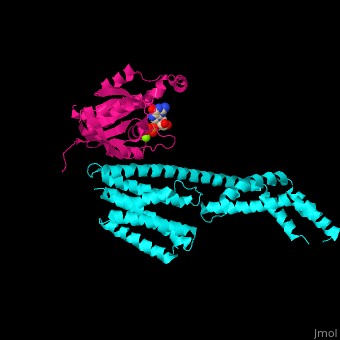Rac
From Proteopedia
(Difference between revisions)
| Line 2: | Line 2: | ||
== Function == | == Function == | ||
| - | The small G-protein '''Rac''' or '''Ras-related C3 botulinum toxin substrate'''. '''Rac1''' is involved in the regulation of cytoskeletal organization, cell adhesion, migration and morphological changes<ref>PMID:23412604</ref>. '''Rac2''' is expressed in hematopoietic cells exclusively<ref>PMID:32542921</ref>. '''Rac3''' binds to a variety of effector proteins to regulate cellular responses like cell spreading and the formation of actin-based protrusions. | + | The small G-protein '''Rac''' or '''Ras-related C3 botulinum toxin substrate'''. |
| + | *'''Rac1''' is involved in the regulation of cytoskeletal organization, cell adhesion, migration and morphological changes<ref>PMID:23412604</ref>. | ||
| + | *'''Rac2''' is expressed in hematopoietic cells exclusively<ref>PMID:32542921</ref>. | ||
| + | * '''Rac3''' binds to a variety of effector proteins to regulate cellular responses like cell spreading and the formation of actin-based protrusions. | ||
== Disease == | == Disease == | ||
Current revision
| |||||||||||
References
- ↑ Asahara S, Shibutani Y, Teruyama K, Inoue HY, Kawada Y, Etoh H, Matsuda T, Kimura-Koyanagi M, Hashimoto N, Sakahara M, Fujimoto W, Takahashi H, Ueda S, Hosooka T, Satoh T, Inoue H, Matsumoto M, Aiba A, Kasuga M, Kido Y. Ras-related C3 botulinum toxin substrate 1 (RAC1) regulates glucose-stimulated insulin secretion via modulation of F-actin. Diabetologia. 2013 May;56(5):1088-97. doi: 10.1007/s00125-013-2849-5. Epub 2013, Feb 15. PMID:23412604 doi:http://dx.doi.org/10.1007/s00125-013-2849-5
- ↑ Lougaris V, Baronio M, Gazzurelli L, Benvenuto A, Plebani A. RAC2 and primary human immune deficiencies. J Leukoc Biol. 2020 Aug;108(2):687-696. PMID:32542921 doi:10.1002/JLB.5MR0520-194RR
- ↑ Prehna G, Ivanov MI, Bliska JB, Stebbins CE. Yersinia virulence depends on mimicry of host Rho-family nucleotide dissociation inhibitors. Cell. 2006 Sep 8;126(5):869-80. PMID:16959567 doi:10.1016/j.cell.2006.06.056

